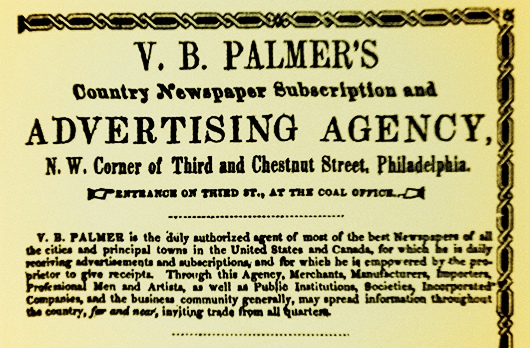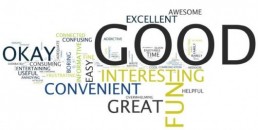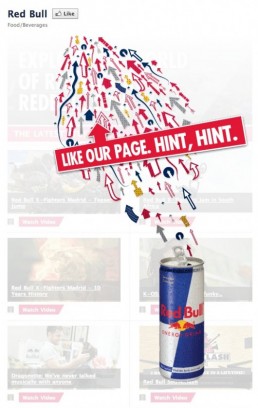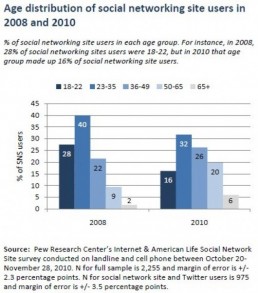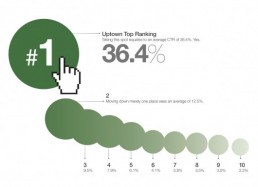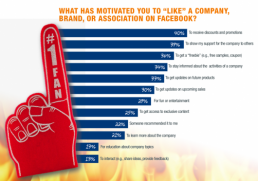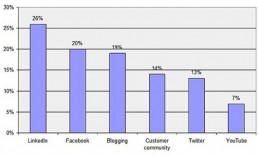Not the same old, same old.
The other day, I was talking with one of my colleagues at Fusion about how much things have changed in our industry over the last decade.
We’ve read articles about serious challenges that face the advertising agency and particularly the threat of Google and technology and how clients will be able to do it all themselves, eliminating the middle man.
The word agency essentially means middle man. An ad agency was actually the middle man in the early days when agencies made all of their revenues from media commissions. Advertising agencies began as “agents” of newspaper ad space. They would buy the ads at an agency discount and sell them to the client at the rate card rate.
The US's first ad agency. (interesting story here)
The rise of digital marketing and social media was said to spell the end of the marketing middle man. Now, a company can speak directly to their market, hear what they have to say and promote themselves. They can do their own Google Pay-Per-Click or place their own Facebook ads. They can get their brand’s creative messaging done with crowd-sourcing, or “desktop publish” in-house (another harbinger to the death of the ad agency twenty years ago).
Instead, as the world of advertising changes, it has become incredibly more complex. The number of marketing channel choices has grown faster than anyone could have imagined and it continues to increase daily. Instead of simplifying marketing as was forecast, the digital age has brought waves of new data cascading down on the business. And smart strategies are only made by comprehending all of the data. Decision paralysis ensues.

Larger version here (click on it).
We used to come up with cool ideas with cool design and decide whether television, radio, print or outdoor was best. Standing out was most of the battle.
Equity research firm Pivotal Research Group mentions in a recent overview of ad agencies: "As marketers have come to face more and more choices for their marketing strategies, they increasingly rely upon external and ostensibly neutral partners—such as agencies—to both filter ideas and support the socialization of initiatives or process changes across the broader organization. This factor is the most critical one which explains why agencies face no credible threat of disintermediation from technology-driven marketing or media platforms."
Traditional advertising agencies will die if they don’t change. But I don’t see many businesses, because it is now easier for them, taking on what we do to create a strategy and sell a product. It is much more difficult than it ever was. You need experts in all of the many alternative traditional and digital channels, and experts in messaging within these channels to get heard and be considered. And you can’t crowd-source a penetrating message without a keen analysis of all of the data, without the experts on the hundreds of channel choices and without the experts who know how to work within them.
We are changing all the time. Things are happening so fast that we are doing things here at Fusion that we didn’t do last year and dropping things that we did last year. Change is a great thing. Advertising has become so much more dynamic and exciting. And it has become a true science. I love it.
Grabbing Attention with Online Ads
People love to look at people. When you show faces, you grab attention. When you show most anything else, you lose attention.
EyeTrackShop is a crowd-sourcing research firm that employs people all around the world to look at advertising or store fronts or anything you like. These lookers around the globe use web-cams with technology that has been calibrated to their eyes and look at your ad for you in their spare time. The collaboration of all these views gives you a good feel for what is and what isn’t attracting attention in your ad or on your online page.
As well, they have shown that the best place for your ad in an online page is top left above the fold (print lingo for what’s showing on the screen before you scroll down).
![]()
I found these photos in an article by Zoe Fox, writing for Mashable. I then went to the EyeTrackShop website for more on the technology. You can sign up to have ads checked or you can licence the technology. I would worry that the viewers might eventually or even at the beginning, be biased, but I’d have to read more on EyeTrackShop’s due diligence before recommending it. They do control for a number of potential biases like time of day, gender and media outlet.
They have coined the term “realCPM” to take the guesswork out of ad placements. They translate what the ad company says you are getting into what you are really getting. Of course, this doesn't directly relate to successful selling, but it certainly is a good starting point. Banner ads do best, followed by left then right placements above the fold.
The report you receive shows the percent of people who saw the ad, how long they looked at it, how long it took for them to notice it and if they recall your brand later on.
Have a look at these sample test images. Faces!
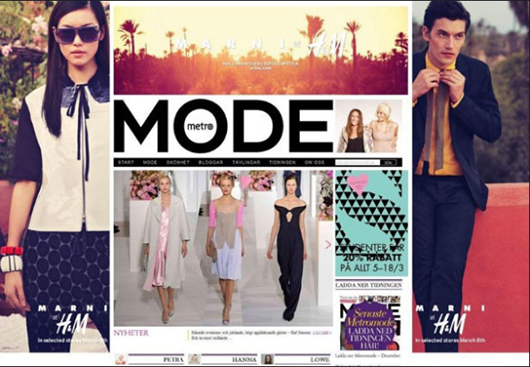

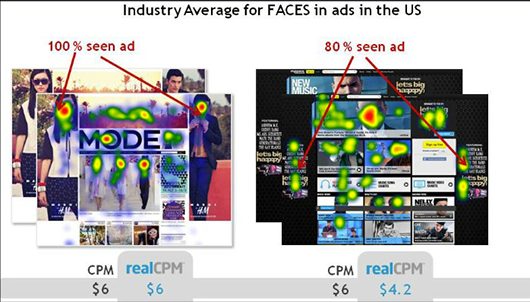
Mobile Users Quick to Leave Your Site if Experience Not Great
We all know that mobile shopping is growing. According to studies by Coremetrics, shopping on smart phones has doubled since last year to 6.5% of retail sales. We also know where that number is going.
Limelight Networks recently surveyed 520 mobile consumers and found users very quick to leave the site if it wasn't up to their expectation of a good experience.
This chart shows what happens when users aren't happy with the site.
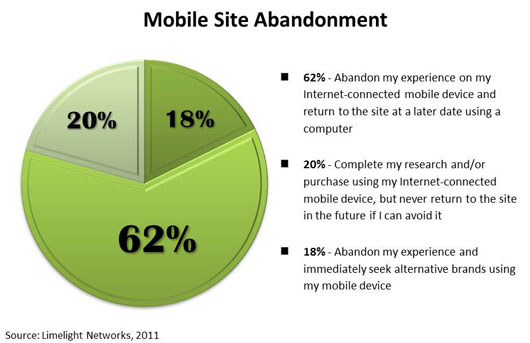
38% leave for good (some after continuing with the one and final purchase), while 62% say they will continue online when they can get to a computer. I wonder how many forget to do that given the ability of the mobile device to allow spontaneous purchases without much forethought and research.
Limelight also found out what is important to the mobile consumer.
- 88% said the load time is a key factor
- 88% found useful imagery as important (able to zoom in on a product, for example)
- 82% said mobile site optimization, or how the site fits the screen, is also key
Consumer expectations don't change when they visit via their smart phone or tablet. They expect an experience as good as they get using their computer. I know that when I visit a site via my iPhone or iPad that uses Flash and won't show me anything, I think negatively of that brand. I recently emailed Volvo about this and I never do that. Expectations are changing very quickly. And Volvo promises to do so too.
Eg. Winnipeg James Armstrong Richardson International Airport
2/3 of online adults use social networking sites
People are loving social networking! After email and search engines, social networking is used more frequently than anything else on the web (Pew Research Center).
Social sites are most popular with women and young adults under 30. 18-29 women are the power users. Nine out of ten women! Seven out of ten use them every day. Older users are the fastest growing bunch. The younger were early adopters and are stable in their growth. 70% of 30-49 year olds use social networking sites. 51% of 50-64 year olds and 33% older than 65 use the sites. 30 to 64 year olds are picking it up fast and are the fastest growing segment.
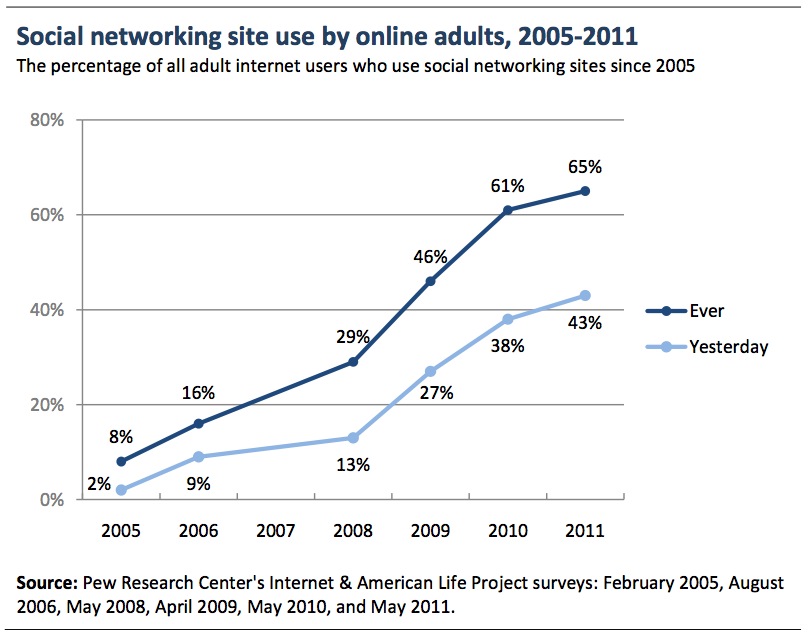
Interestingly, Pew Research found that there are no significant differences in use of social networking sites based on race and ethnicity, household income, education level, or whether they live in an urban, suburban, or rural environment.
The top word graphic shows what single word people said about social networking in this study (largest words mean more people said it).
Communicating on your Facebook Business Page
Your Facebook business page can be addictive and very time-consuming, and it can also be sadly neglected and left for dead. Of course, some where in the middle is where you need to be.
Posting updates more than once, or maybe twice per day is about the most we suggest you do. If you are always on your fans’ walls, and your message isn’t always titillating and timely, they’ll drop you quickly.
Being “liked” on Facebook, as a business, is a privilege. It is an offer from a customer or prospect to communicate and it must be taken seriously. While it can be a place for sales notices and company information, the more of that you do, the more you look like spam and the faster they’ll drop you.
Facebook is your opportunity to build a customer relationship that can become quite intimate, one-on-one. It is your chance to listen to your customers and to share information that they desire to make better buying decisions and to maintain loyalty.
As a person’s Facebook wall continues to scroll and messages fall out of sight, it is useful to find the most opportune posting times of the day. Look at posts that got the most comments and determine the time of day they were posted. You should also use Facebook Insights, which let’s you monitor interactions on your page over a set time period.
Two other quick tips, after ensuring that you have a Facebook “business page”, not a personal profile page, is to create a strong call-to-action for visitors to “like” you (the Red Bull example above is an excellent one with nothing but a call-to-action), thereby opening the door to communication, and include keywords as often as you can in your status updates, photo captions and anywhere else you can. Talk to your community, speak their language, thank them, reward them and listen to them.
At Fusion, we help our clients manage their Facebook, Twitter and other social networking accounts, ensuring that we create a strong and consumer-oriented brand voice and messaging strategy.
Social Media Growing with Middle-aged People
Pew Research has just released a study called “Social Networking Sites and our Lives,” by Hampton, Goulet, Rainie and Purcell.
It appears that Facebook, Twitter, LinkedIn and the like are no longer the bastions of the youth of the world. From 2008 to 2010, social networking site users over 65 have grown from 2 to 6 percent and those aged 50-65 have grown over the same period from 9 to 20 percent of the total user audience.
This growth in the middle-aged and older segments has huge implications for brands and their marketing efforts. A good Facebook strategy can now target a significant number of customers older than 50. I would bet that next year, we’ll see similar if not ever greater growth.
Social networking is enhancing our relationships with people we haven’t seen for a long time and it is viral. When one friend starts, he or she hits all of their core friends and it keeps going. It revives dormant relationships, the report says.
This is great news for marketers. At Fusion, we have been getting increasingly great responses with the use of integrated and Fusion-managed social media strategies for many of our clients.
Number One on Google attracts 36 percent of Traffic
It's worth your while to find an SEO Company in Winnipeg, today. Working your SEO strategy to ensure that you rank number one on Google means, on average, you will get as much traffic as the second, third, fourth and fifth highest ranked positions combined. A study by Search Engine Watch found that the highest ranked website on Google received over 36% of the total traffic (organic search, not including ads), while second highest got only 12.5%. It pays to have a good Search Engine Optimization Strategy.
Consumers brag about their brand preferences
According to a study by ExactTarget and CoTweet, over one-third of Facebook users who become fans of businesses do it to show their support for the company to others. Around the same number of Facebook business fans do so for discounts, so keep them loyal with super deals and great customer service and they’ll brag about you and introduce you to others.
Interestingly, 43% of Facebook users say they “Like” or are fans of at least one brand on Facebook.
Your viral press release
When it was time to make a corporate announcement or release some news, it used to be that you would post to the newswires and work the media praying for some uptake. That has changed quite dramatically in recent years.
These days, if you release a press release on the net with some real news, on paid and/or free sites, you can very quickly get thousands of postings and some real traffic (hackers and spammers included). You can also get some serious media attention.
The automated bots crawling the web are picking up content that is often pulled into credible websites that report real news. They’re also finding content that gets posted to websites that don’t have any reporters at all, reporting exactly what you said and what they scrape off the web. Most of these automated sites grab the press release, run ads beside it and make a little cash off of your story. They are often difficult to distinguish from the harder-working, journalistic sites, until you read the next article and you wonder why they ever reported that next story at all. But, it’s all good.
We recently helped to launch an online virtual world created by a Winnipeg company, called Weopia, that is focused on the online dating industry, and they received boatloads of publicity from around the world after an online press release and some serious working of the media contact lists. But, the sheer volume of stories in countries all around the globe, on websites we had never heard of, and from reporters, we had never talked to, was astonishing.
Bots were grabbing our content and websites were grabbing it from them and translating it into new languages, but real people with blogs and news sites were grabbing it as well. They would go to the Weopia website, try the product, or simply add a little take of their own and post a new story. And every once in a while a national TV or radio reporter would call to do a Skype interview, or a newspaper would call with questions and to ask for additional photographs. And traffic on the website grew and grew.
One year later, it still gets reported on. The web is an amazingly intricate network of ever-changing links and connections between real people and automation that can work wonders on a little bit of news.
The above image illustrates in 3-D the actual domains and connections of the world wide web (courtesy, www.opte.org).
LinkedIn Tops in Social Media for Business to Business Marketing
Of all the social media marketing tools that business to business marketers use, LinkedIn ranks as number one. A report by B2B Online states that over 25% of social B2B marketers picked LinkedIn as their most important tool. 20% mention Facebook while 19% say Blogging is most important. Interestingly, only 13% selected Twitter as their number one tool and YouTube is tops for just 7%.
They are used for different purposes, of course...LinkedIn more for lead generation and Facebook for promotion.
Social Media Marketing Landscape
75% of B2B social marketers do not measure their ROI for these tools, but Bob Felensthal, B2B Publisher, says they do enjoy an average of a 10% lift in website traffic.
Sources: B2B Online www.btobonline.com/section/researchreports5
MarketingProfs www.marketingprofs.com/charts/2011/4837/linkedin-top-social-tool-for-b2b-marketers
